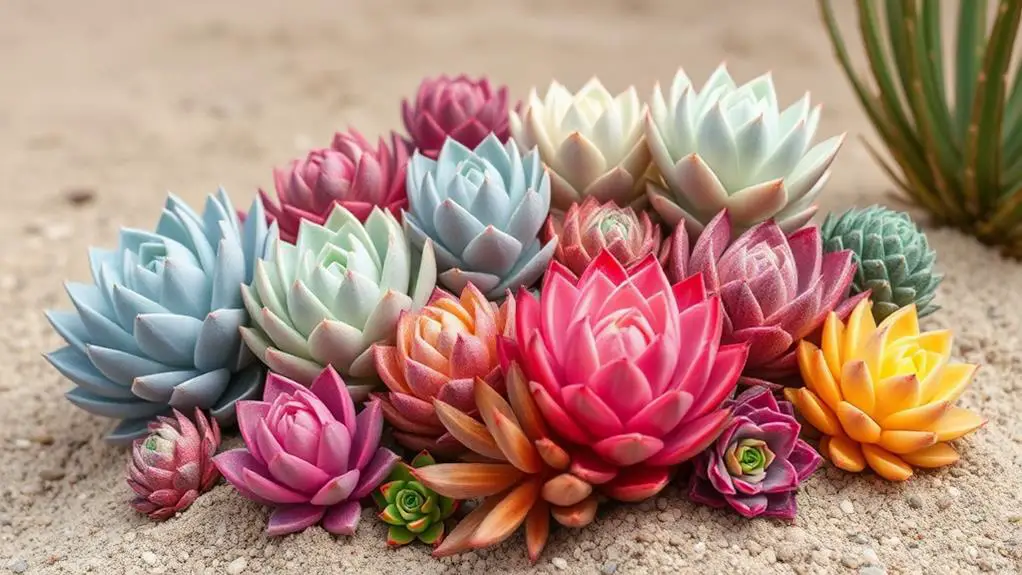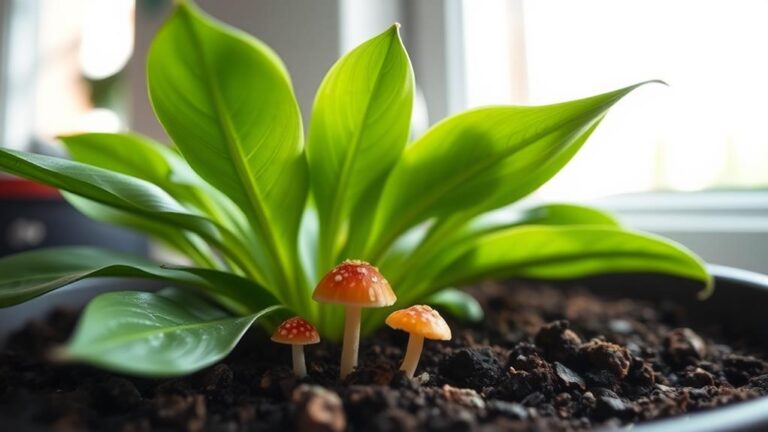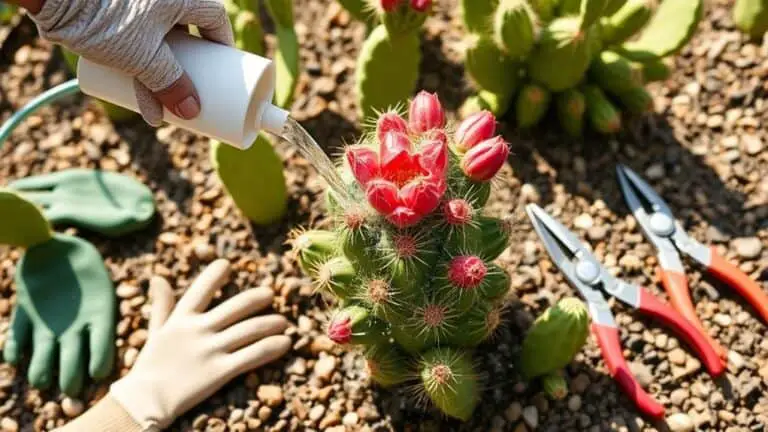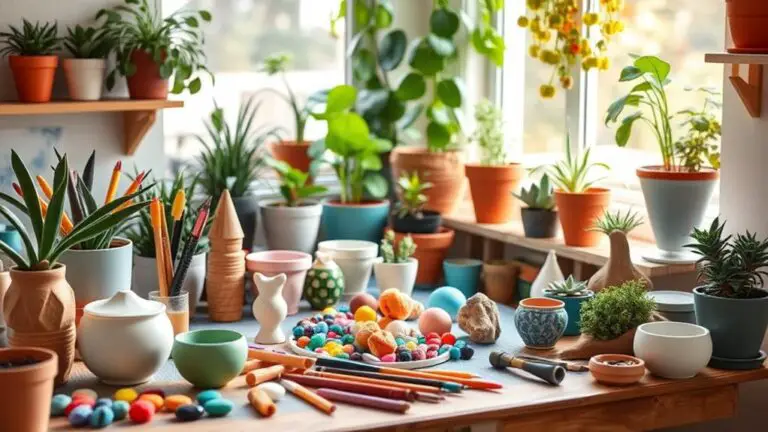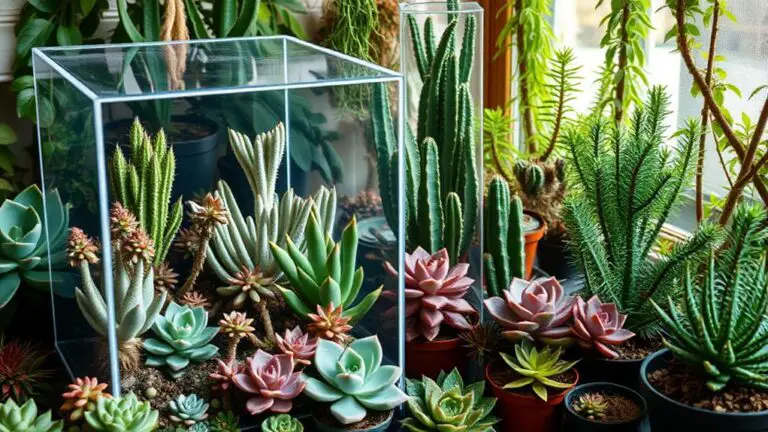What Are Crested Succulents?
When you hear about crested succulents, you might initially think they're just another type of plant, but there's more to them. These succulents develop from a fascinating genetic mutation in their growing tips, leading to unique, twisted shapes that are anything but ordinary. You might wonder how this mutation, known as "cristata," affects their care and whether they need special attention compared to regular succulents. Understanding their distinctive growth patterns and maintenance needs can transform how you view and tend to these botanical curiosities. So, what makes these plants stand out in the succulent world?
Definition and Formation
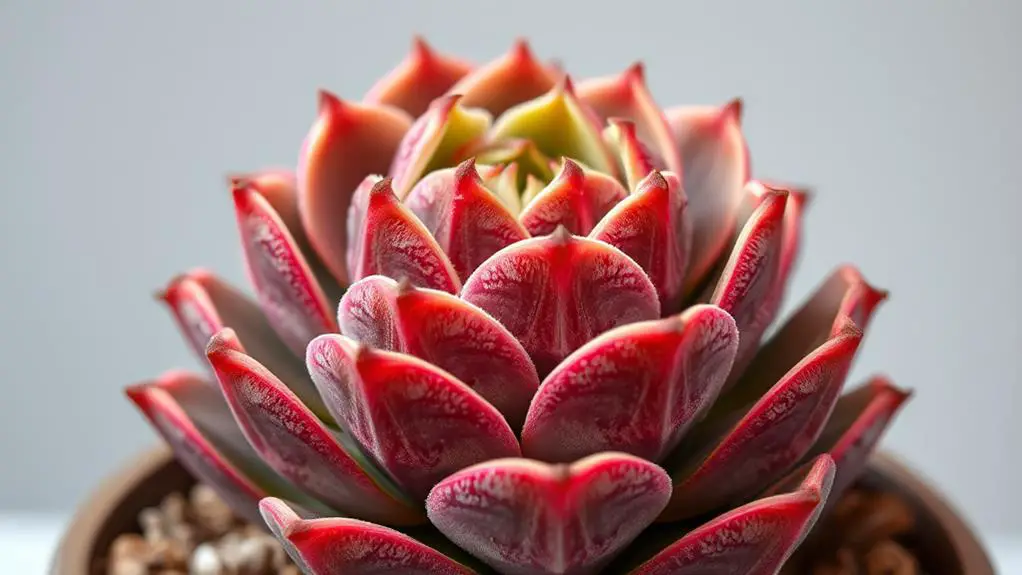
Crested succulents, distinguished by a genetic defect in the apical meristem, develop unique and often twisted shapes due to multiple growing points instead of a single one. This fascinating mutation occurs naturally when a single growing point sustains physical damage. As a result, the plant's growth becomes crowded, leading to their distinctive, compact structures.
In standard succulents, growth typically follows a predictable, branching pattern. However, in crested succulents, the leaves grow along the ridge of their flattened forms, creating a striking visual difference. This mutation, often referred to as "cristata," adds a unique touch to any plant collection.
It's important to know that these mutations can't be artificially induced, making crested succulents rarer and more valuable to enthusiasts.
You might come across the term "monstrose" when researching these plants. While similar, monstrose succulents exhibit irregular and unpredictable growth patterns due to genetic mutations, but not specifically in the apical meristem.
Understanding these unique plants can enhance your appreciation for their beauty and rarity. Embracing the challenge of growing crested succulents can be rewarding, adding a distinctive flair to your gardening experience.
Enjoy the process and take pride in cultivating these extraordinary plants.
Unique Growth Patterns
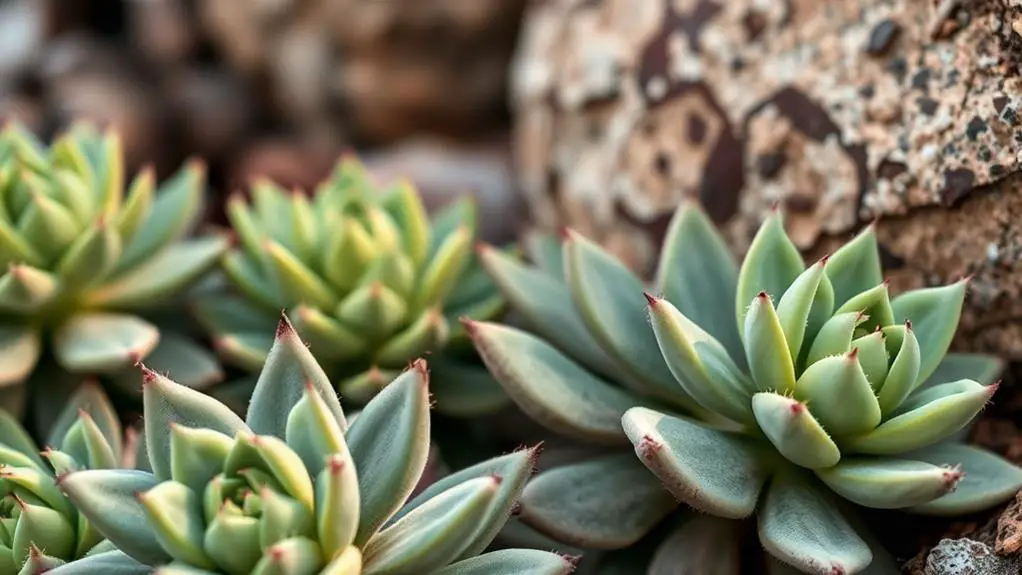
Crested succulents have unique growth patterns because of a genetic mutation in their apical meristem. This mutation causes the plants to develop broad, flat structures instead of the usual branches, leading to fascinating shapes that look like natural sculptures.
To keep these distinctive forms, you'll need to regularly prune them, as parts of the plant might revert to standard growth without proper care.
Genetic Mutation Causes
The fascinating world of crested succulents showcases how a genetic defect in the apical meristem can lead to extraordinary growth patterns. When this defect occurs, the plant's single growth point transforms into multiple points. This abnormal growth creates unique shapes with flattened stems and crowded foliage, setting them apart from standard succulents.
The process called fasciation is responsible for these stunning changes. Here, the growth cells flatten into broad, fan-like structures, giving crested succulents their distinct appearance. It is essential to recognize that this genetic defect happens naturally and can't be artificially induced or replicated, making crested varieties rare and special.
Both cresting and monstrose types of succulents result from similar genetic defects. However, monstrose growth features more erratic and asymmetrical shapes, unlike the flat and twisted forms typical of cresting.
Here's a helpful table to summarize:
| Feature | Crested Succulents | Monstrose Succulents |
|---|---|---|
| Growth Point | Multiple | Multiple |
| Stem Shape | Flattened | Erratic |
| Foliage Appearance | Crowded | Asymmetrical |
| Mutation Type | Natural, not replicable | Natural, not replicable |
| Rarity | Rare | Rare |
Understanding these genetic mutations helps you appreciate the unique beauty of crested succulents and confidently care for them.
Distinctive Plant Forms
Exploring the genetic anomalies that shape these extraordinary plants leads us to the distinctive plant forms they exhibit. Crested succulents stand out due to a mutation in their apical meristem, which causes them to grow in flattened, wide surfaces rather than the usual branching patterns of a normal plant. This unique growth results in leaves that grow compactly along a ridge, creating fascinating forms that can look like twisted geological formations or even marine life.
As you care for these plants, you'll notice that crested succulents develop multiple growing points. This can make them appear crowded and intricate, a feature that makes them highly desirable among collectors. However, be mindful of the possibility of reversion, known as defasciation, where the plant might revert to its normal growth pattern, losing its distinctive appearance.
Interestingly, crested and monstrose forms can both appear on the same plant. While crested varieties have an organized structure, monstrose forms are characterized by their random and asymmetrical shapes. This makes each plant truly unique.
With careful attention, you can maintain these fascinating forms and enjoy the extraordinary beauty of your crested succulents.
Care Requirements
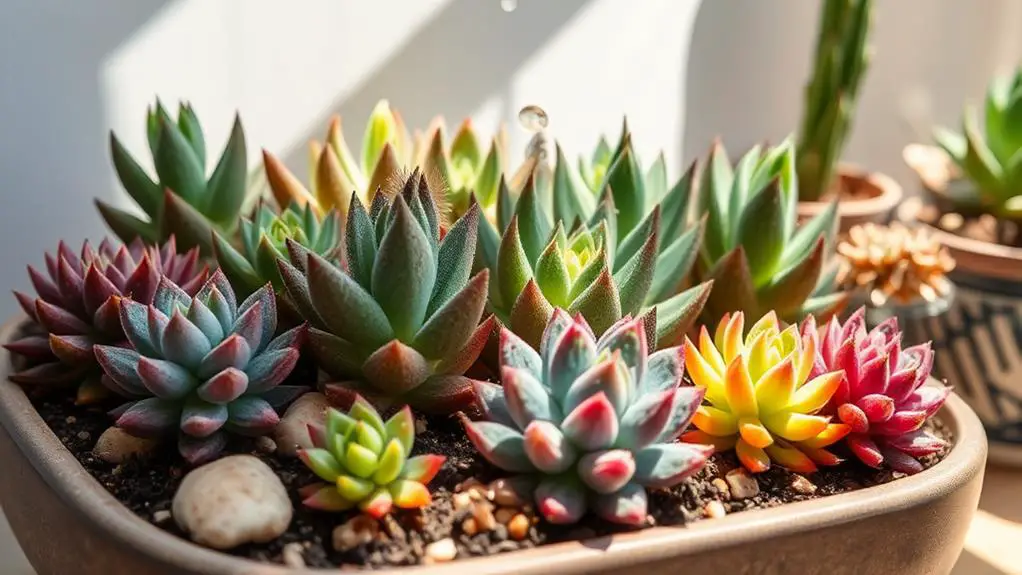
Taking care of crested succulents demands a gentler touch than tending to standard varieties. These unique plants require low maintenance but thrive with regular observation. To support their crested growth, place them in high-light environments, preferably near a sunny window. This guarantees they get all the light they need to maintain their striking appearance.
Watering is a significant aspect of their care. Crested succulents need less water than their standard counterparts. Overwatering can lead to rot, so let the soil dry out completely between waterings. Use a well-draining potting mix to avoid moisture retention, which is essential for preventing root rot.
Minimize fertilization to keep your crested succulents healthy. Too much fertilizer can harm their delicate structure. A light feeding once or twice a year is usually sufficient.
Regular observation is key. Watch for signs of stress, like discoloration or mushy leaves, which can indicate overwatering or pests.
Pruning is necessary to maintain the crested form. Sometimes, parts of the plant may revert to normal growth. Trim these sections to keep the plant's unique shape.
With gentle care and attention, your crested succulents will flourish beautifully.
Common Varieties
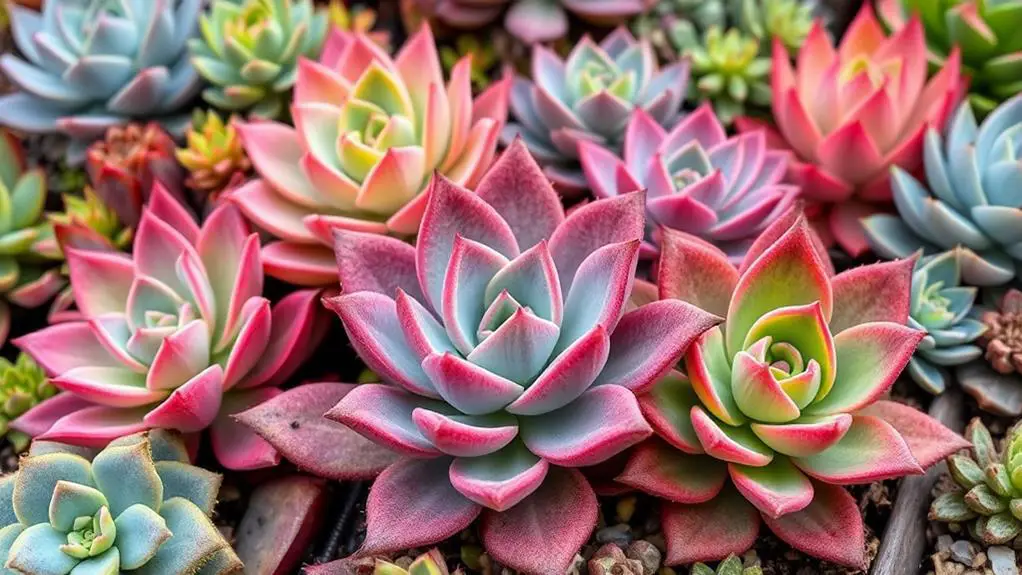
When it comes to common varieties of crested succulents, you'll find some truly unique and eye-catching plants.
Popular crested Aeoniums, like the Crested Aeonium Sunburst, show off a mix of white, yellow, and green leaves, while unique Echeveria varieties, such as the Crested Cubic Frost Echeveria, feature stunning lavender frosty leaves.
These plants not only bring vibrant colors to your garden but also have specific growing habits and care needs to keep in mind.
Popular Crested Aeoniums
Diving into the world of popular crested Aeoniums, you'll find some truly enchanting varieties that stand out with their unique appearances and growth patterns.
These crested succulents, a fascinating subset of succulent plants, exhibit monstrose growth, resulting in intriguing and unusual shapes.
One standout is the Crested Aeonium Sunburst, featuring striking white, yellow, and green leaves. It's known for its compact growth and dormancy during the summer months.
Another eye-catching variety is the Aeonium Starburst, celebrated for its unique rosette formation and vibrant coloration, making it a favorite among succulent collectors.
The Crested Aeonium Kiwi showcases bright green leaves with a reddish margin, creating a stunning contrast in any succulent arrangement.
Meanwhile, the Crested Aeonium arboreum develops a flattened, fan-like structure with deep green leaves, adding an unusual aesthetic to any garden.
Lastly, the Crested Aeonium 'Topsy Turvy' presents a whimsical appearance with its twisted growth pattern. This makes it a sought-after variety for enthusiasts who enjoy a bit of quirky charm in their gardens.
Each of these varieties offers something special, ensuring your collection of crested succulents will be both unique and beautiful.
Unique Echeveria Varieties
Exploring unique Echeveria varieties, you'll be amazed by the stunning range of colors and shapes they offer. These crested or monstrose succulents make a fascinating addition to any succulent collection.
One standout variety is Echeveria Cubic Frost™. Its frosty lavender leaves form unique, cubic shapes that collectors love. If you're looking for something rare and eye-catching, this is it.
Next, there's the Crested Echeveria Frosty, which features furry rosettes covered in silvery-white hairs. During summer, it produces vibrant yellow-orange flowers, adding a pop of color to your garden.
Don't miss Echeveria 'Topsy Turvy'. Its twisted leaves spiral upward, creating a striking look that's sure to grab attention.
Then there's the Crested Blue Atoll Echeveria. With its evergreen, light blue-green leaves and bright orange and yellow flowers, it brings both color and texture to your garden.
Lastly, consider the Crested Aeonium Sunburst. Its blend of white, yellow, and green leaves is truly unique. Plus, it goes dormant in summer, making it an intriguing addition to your succulent collection.
Each of these unique Echeveria varieties offers something special, ensuring your garden stands out.
Reversion to Normal Growth
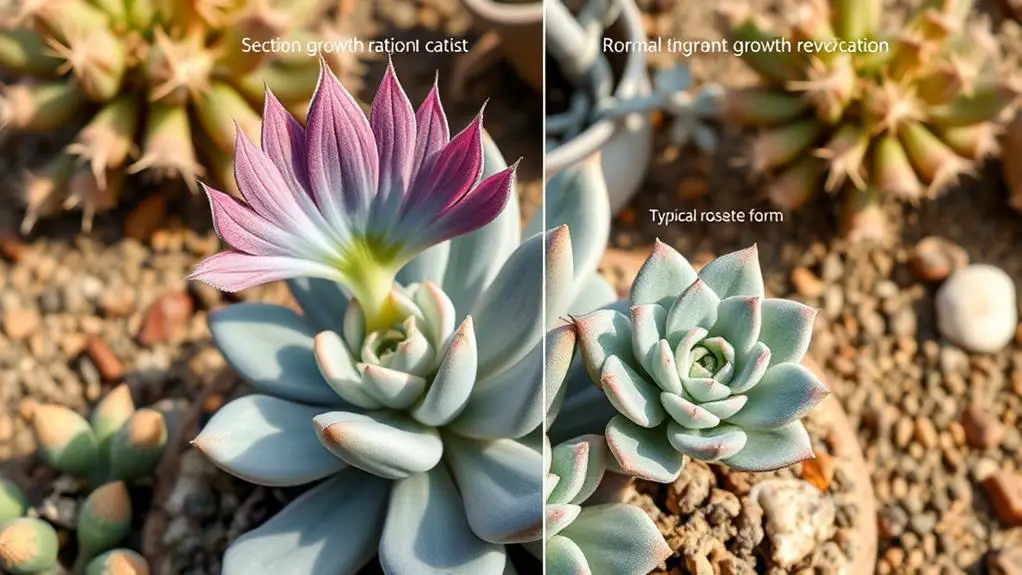
Crested succulents can sometimes revert to their normal growth patterns due to a phenomenon known as defasciation. This happens when the plant becomes overcrowded and stressed.
To maintain the unique appearance of your crested succulents, regular pruning is essential. By removing any normal growth, you help the plant focus on its crested form, which is what makes it so special.
Monitoring the growth is also vital. Parts of the plant may revert to standard growth patterns if not properly managed. This reversion process can diminish the plant's aesthetic value, which is why you should be vigilant about their care.
Keep an eye on your succulents and act quickly if you notice any changes. To prevent reversion, make sure your succulents have enough space to grow. Overcrowding can stress the plant and encourage it to revert to normal growth.
Additionally, avoid overwatering. Too much water can exacerbate stress and contribute to defasciation. By following these steps, you can help your crested succulents thrive and maintain their unique appearance.
Propagation Techniques
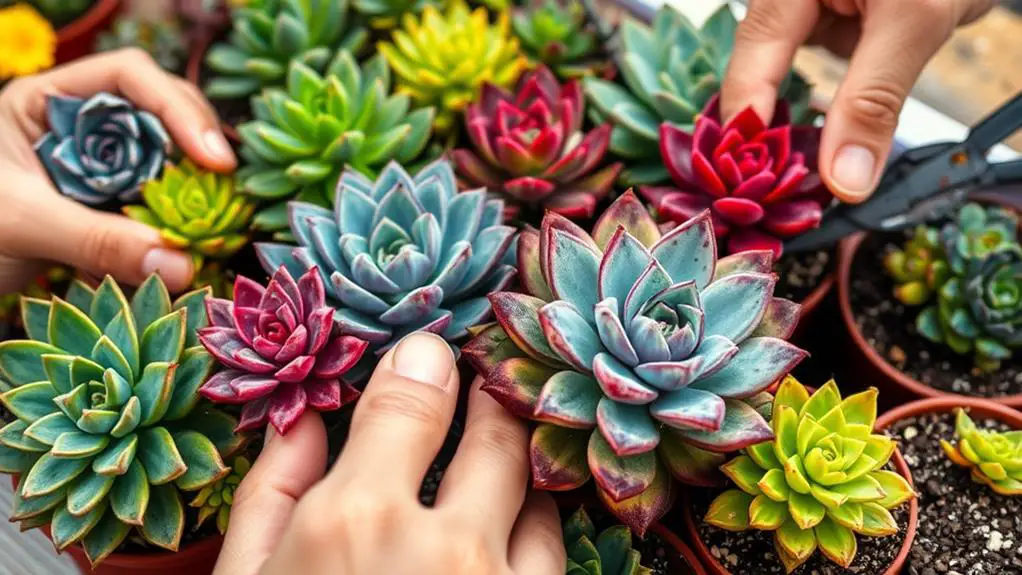
Propagating crested succulents might seem intimidating at first, but with the right techniques, you can successfully grow new plants from cuttings. To begin, take cuttings from the cresting parts of the plant. These are more likely to maintain the unique growth patterns you're after.
Once you've taken your cuttings, it's important to allow them to callous over for a few days. This helps reduce the risk of rot when you plant them.
Here are some steps to guide you through the process:
- Select a healthy cresting section: Choose a part that shows strong, unique growth.
- Allow the cuttings to callous: Let them dry in a shaded area for several days.
- Use well-draining soil: Plant the calloused cuttings in soil that won't hold too much water.
- Monitor for stress: Keep an eye on your cuttings to make sure they don't revert to standard growth.
Unlike regular succulents, crested varieties can be more challenging to propagate due to their genetic traits.
Sometimes, grafting onto a hardy rootstock can help by providing a stronger base for the unusual growth structures. Regular monitoring is vital to guarantee your cuttings maintain their crested form and don't revert to normal growth.
With patience and care, you'll soon have a thriving collection of crested succulents.
Pest and Disease Management
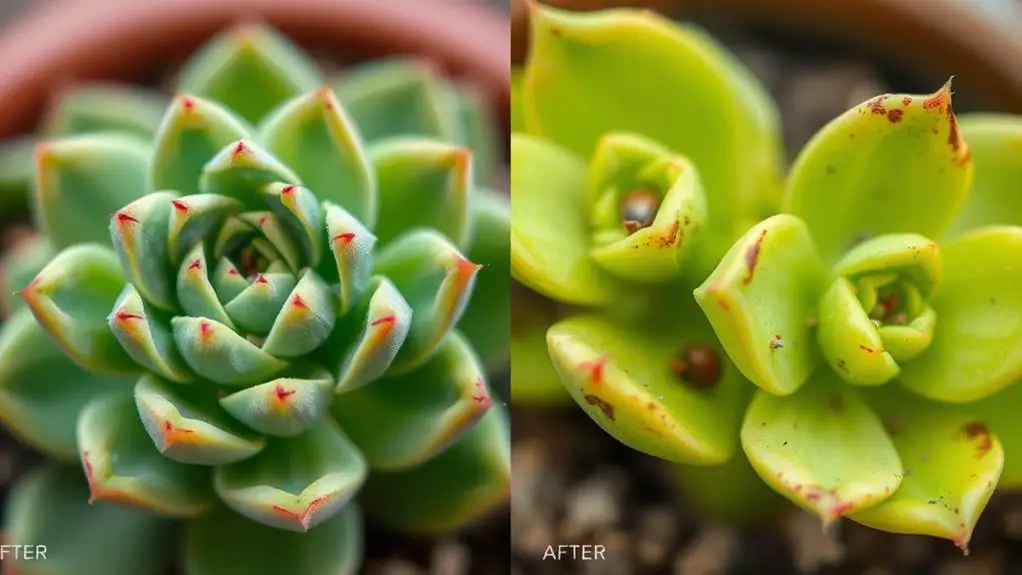
Managing pests and diseases in crested succulents is important to keep them healthy and thriving.
You should regularly check for pests like thrips, mealybugs, and scale, and use insecticidal soap or neem oil to control them gently.
Also, remember to maintain good air circulation and avoid overwatering to prevent fungal infections and root rot.
Common Pest Infestations
When dealing with common pest infestations in your crested succulents, vigilance is key.
These unique plants, with their dense and convoluted growth patterns, can easily hide pests like mealybugs, thrips, and scale. Regular inspection is vital to catch these pests early and maintain plant health.
To help you manage pest infestations, here are some practical steps:
- Inspect frequently: Regularly check your crested succulents for any signs of pests. Look closely at the nooks and crannies where they might hide.
- Use insecticidal soap or neem oil: These treatments are effective and safe for your plants. Apply them as directed to control and eliminate pests.
- Maintain proper watering: Overwatering can lead to rot and stress, making plants more vulnerable to pests. Confirm your succulents have well-draining soil and a consistent watering schedule.
- Quarantine new plants: Before adding new plants to your collection, isolate them for a few weeks. This practice helps prevent the spread of pests to your existing succulents.
Disease Prevention Tips
Caring for crested succulents involves a few key disease prevention strategies to guarantee their health and longevity.
First, regularly inspect your plants for pests like thrips, mealybugs, and scale. These pests love the tight folds of crested succulents. Early detection and pest control with insecticidal soap or neem oil can save your plants from serious damage.
Maintaining proper air circulation is another important step. Good airflow reduces humidity around your succulents, which helps prevent fungal infections and rot. You don't want moisture to linger, as this can lead to disease. Keep your plants in a spot where they can breathe.
One of the biggest threats to crested succulents is overwatering. These plants need their soil to dry out completely between watering sessions. Overwatering can cause root rot, especially given their unique growth patterns.
Use a well-draining potting mix, enriched with perlite or sand, to ascertain water doesn't pool around the roots.
Effective Pest Control
Your crested succulents' unique structures can make them a prime target for pesky invaders, so effective pest control is vital. Regular inspections are your first line of defense. Pests like thrips, mealybugs, and scale can hide in the tight folds of your plants, causing significant damage if not caught early.
To keep your crested succulents healthy, follow these tips:
- Regularly inspect your plants for signs of pests, especially in the folds.
- Apply insecticidal soap or neem oil according to the manufacturer's instructions.
- Guarantee proper air circulation to prevent fungal infections and overcrowding.
- Quarantine new plants for several weeks before introducing them to your collection.
Using insecticidal soap or neem oil helps you handle infestations without harming your plants' unique structures. Always read and follow the instructions for safe and effective use.
Good air circulation around your succulents prevents both fungal infections and pest infestations, so don't let them get overcrowded.
Purchasing Tips
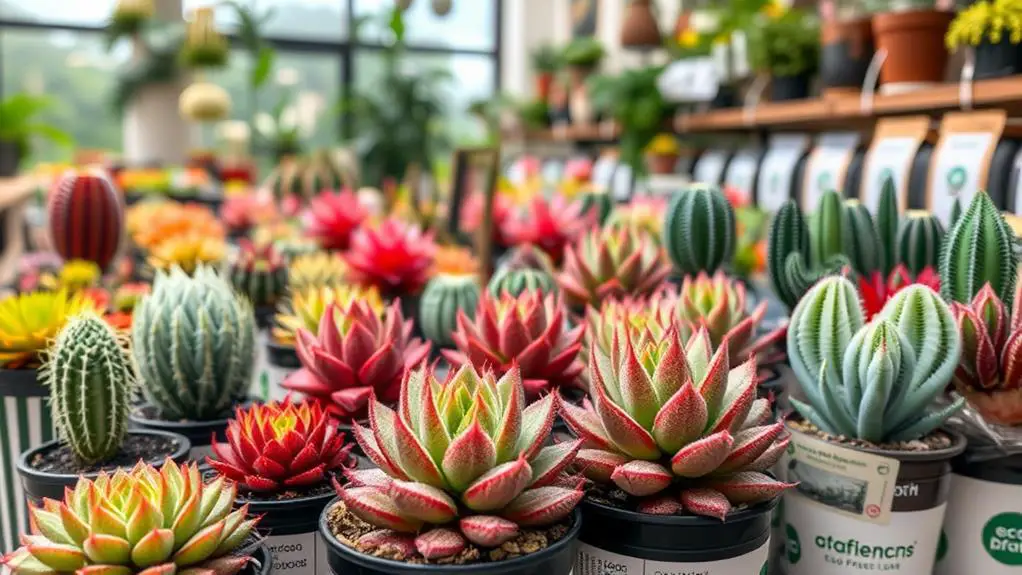
Finding the perfect crested succulent starts with choosing reputable sources. Specialty nurseries and online platforms like Etsy and Amazon are good places to start. When you purchase through links on these sites, you're more likely to get authentic and healthy crested succulents. It's also essential to compare prices since they can vary widely due to the rarity of these plants. Checking customer reviews and ratings will help you gauge the quality of both the plants and the customer service.
Here's a quick table to help you compare options:
| Vendor | Price Range | Customer Rating |
|---|---|---|
| Etsy | $20 – $150 | 4.5/5 |
| Amazon | $15 – $100 | 4/5 |
| Specialty Nursery | $30 – $200 | 4.8/5 |
Community and Culture
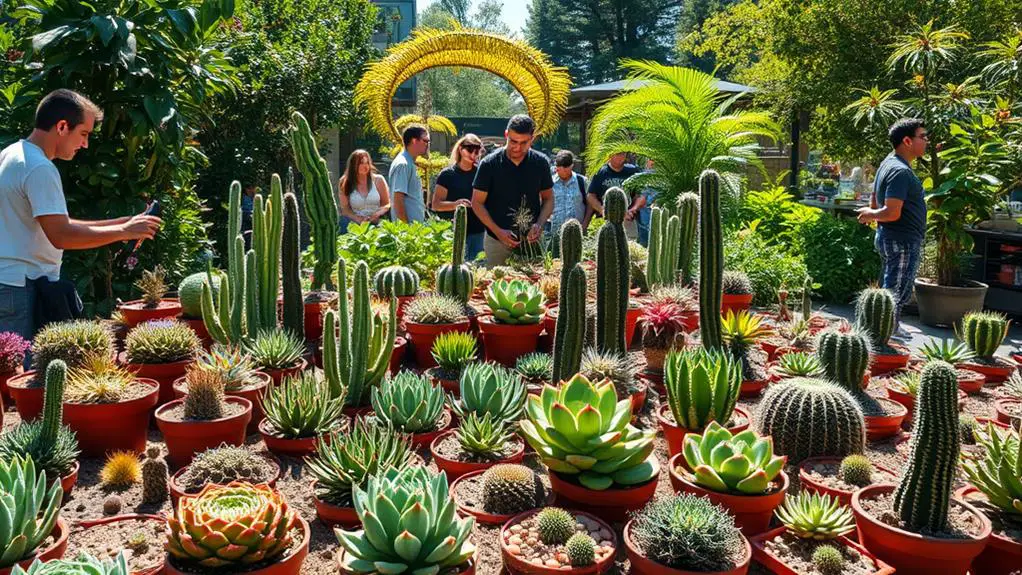
The fascination with crested succulents has cultivated a vibrant community of enthusiasts who enthusiastically share their knowledge and experiences. This growing interest has fostered a supportive environment where you can learn and exchange tips with fellow collectors.
Social media platforms buzz with activity as members showcase their unique collections and discuss care techniques.
Imagine a space where you can:
- Ask questions and get advice on maintaining your crested succulents
- Participate in plant swaps and succulent shows to engage with other collectors
- Read dedicated blogs and websites focused on care and cultivation
- Join online forums and groups where everyone shares their love for these rare plants
By connecting with this community, you'll find plenty of resources and support to help your crested succulents thrive. Collectors often share their experiences, making it easier for you to learn from their successes and challenges.
Whether you're a beginner or an experienced gardener, there's always something new to discover.
Engaging in this community means not only enhancing your knowledge but also enjoying the camaraderie of like-minded individuals who share your passion for these fascinating plants.
Don't hesitate to plunge into and explore all that this vibrant community has to offer.
Additional Resources
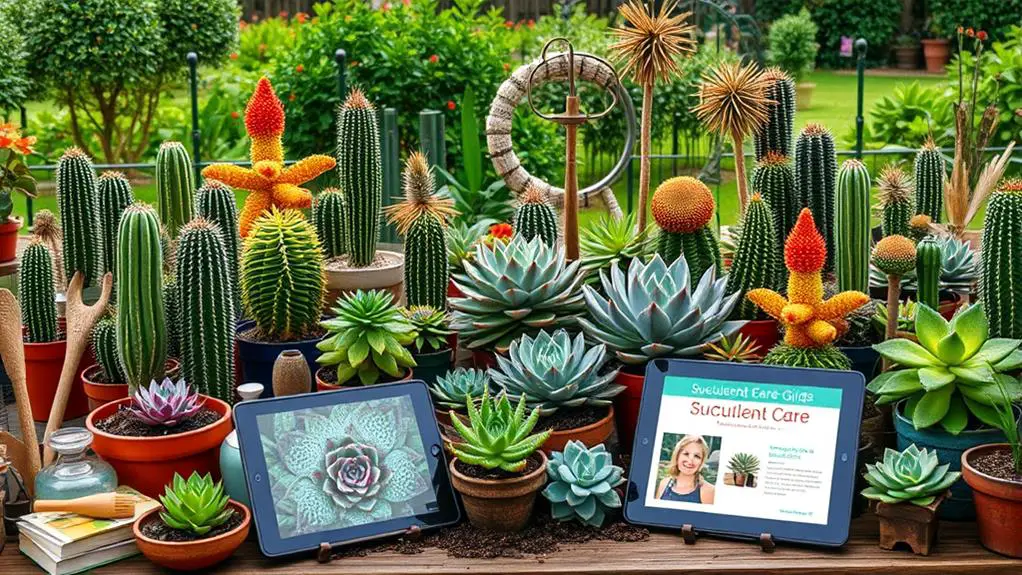
Exploring additional resources can greatly enhance your journey with crested succulents. These unique plants have specific needs, and learning from various sources can make growing succulents more enjoyable and successful. Specialty nurseries like Mountain Crest Gardens, Leaf & Clay, and The Succulent Source offer a wide range of crested and monstrose succulents. You'll find unique specimens to add to your collection and helpful growing tips from these experts.
Gardening Know How is another excellent resource. Their newsletter provides free DIY eBooks and updates on gardening, including propagation techniques for succulents. This can be incredibly useful for expanding your gardening skills. Additionally, online articles help you understand the differences between cacti and succulents, ensuring you provide the best care for your plants.
Joining social media platforms and online communities can also be beneficial. These spaces allow you to share experiences, tips, and photos of your crested collections, fostering a supportive environment. For visual learners, infographics detailing rosette succulent types and variegated succulents' characteristics are valuable tools.
Here's a quick guide to some helpful resources:
| Resource Type | Description |
|---|---|
| Specialty Nurseries | Mountain Crest Gardens, Leaf & Clay, The Succulent Source |
| Newsletters | Gardening Know How – Free DIY eBooks and gardening tips |
| Online Articles | Differences between cacti and succulents, specific care requirements |
| Social Media/Communities | Share experiences, tips, and images with other enthusiasts |
Frequently Asked Questions
What Does It Mean for a Succulent to Be Crested?
When a succulent is crested, it means the plant has experienced a mutation at its growing point, causing it to develop unique, flattened, fan-like structures. These rare formations make crested succulents highly desirable among collectors.
Do Crested Succulents Grow Slower?
Yes, crested succulents grow slower. Their unique mutations and crowded growth points compete for resources, slowing them down. Lack of chlorophyll in parts and sensitivity to light and watering also contribute to their reduced growth speed.
How Does a Cactus Become Crested?
A cactus becomes crested due to a genetic defect in its apical meristem, causing multiple growing points. Physical damage to the growing tip can also trigger this abnormal growth, resulting in a unique flat, fan-like structure.
How Do Plants Become Crested?
Plants become crested due to genetic mutations in their growth tips, often caused by physical damage. Environmental factors like injuries or nutritional deficiencies also play a role, leading to the unique, fan-like structures you see in crested plants.
Conclusion
Caring for crested succulents isn't just rewarding; it's also a fun journey. With their unique shapes and easy maintenance, they're perfect for any plant lover. By following simple steps like providing enough light, regular pruning, and watching for pests, you'll keep your plants healthy and vibrant. Don't be afraid to experiment and learn as you go. Your dedication will pay off, and you'll enjoy a stunning, one-of-a-kind collection. Happy gardening!

